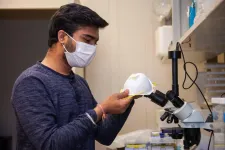"I've long been concerned that if kids grow up too fast, their brains will mature too fast and will lose plasticity at an earlier age. Then they'll go into school and have trouble learning at the same rate as their peers," says Mackey, an assistant professor in the Department of Psychology at Penn. "Of course, not every kid who experiences stress or [is] low income will show this pattern of accelerated development."
What would help, she thought, was a scalable, objective way—a physical manifestation, of sorts—to indicate how children embodied and responded to stresses in their world. Eruption timing of the first permanent molars proved to be just that.
In the Proceedings of the National Academy of Sciences, Mackey, with doctoral student Cassidy McDermott and colleagues from Penn's School of Dental Medicine and the University of Missouri-Kansas City, shows that children from lower-income backgrounds and those who go through greater adverse childhood experiences get their first permanent molars earlier. The findings, generated initially from a small study and replicated using a nationally representative dataset, align with a broader pattern of accelerated development often seen under conditions of early-life stress.
"It's really important for us to understand how to detect early maturation sooner," Mackey says. "Right now, we're relying on seeing when kids hit puberty, which might be too late for some meaningful interventions. If we can inexpensively see that a child is experiencing this maturation earlier, we might be able to direct more intervention resources toward them."
A novel rating system Broadly speaking, Mackey's lab studies how the brain changes and grows as people learn. It's well-established that stress during childhood speeds up maturation and that children who hit puberty earlier are at greater risk for both physical and mental health problems in adulthood.
Beyond that, in studies across primate species, molar eruption has been used to measure childhood length and correlates with a number of other developmental events. Similarly, for humans, the timing of dental events often plays a role in estimating biological age.
"That all made molar eruption a compelling developmental indicator," says McDermott, who is training to be a clinical psychologist.
It helped that more than 100 children, ages 4 to 7, had been participating in two Penn brain development studies, which included structural and functional MRI scans. "There's one type of MRI scan called a T2 weighted scan where you can visualize the morphology of the tooth pretty well," McDermott says. These scans—typically used to look at the brain—showed the researchers just how close these molars were to breaking through the gum line.
Once Mackey and McDermott realized this, they partnered with Katherine Hilton, then a student in Penn Dental Medicine, and Muralidhar Mupparapu, a professor in the Department of Oral Medicine, who developed a novel scale to precisely rate each tooth's position.
"The scale ranges from 1 to 4," McDermott says. "At the low end of the scale is 1, which is before the tooth has really developed at all. As the tooth emerges, there are intermediate stages, and the highest rating, a 4, is when the tooth is fully in the mouth and parallel with the other teeth." Four molars each received a score, which then got averaged, leaving a single score per individual.
Controlling for factors like age and gender, the researchers then looked for associations between early environment and molar eruption. "What we found is that income and adverse childhood experiences are both individually associated with molar eruptions status," McDermott says.
Replicating the findings Those findings derived from just 117 participants, so although the correlation was clear, Mackey and McDermott hoped to replicate what they'd seen.
Collaborators at the University of Missouri-Kansas City told them about a large population-representative dataset called the National Health and Nutrition Examination Survey (NHANES), which is publicly available and includes dental data, demographic data, and family income, among other measures.
"Because our sample is only from one city and is much smaller than a population-representative study like that," McDermott says, "we saw it as an opportunity to verify that the findings exist outside of what we had collected in Philadelphia."
Though some facets differed—NHANES measures dental development a little differently, for example—the models showed similar results, indicating a connection between lower family income and earlier first molars.
Whether this overall trend is new or just now coming to light is something Mackey wants to study further. She's also curious about when the rate of maturation gets set. "Is it as early as in utero or is it dynamically adjusted based on stressors in the world?" she says. "If it's the latter, that tells you there are more opportunities to intervene."
Present implications, future work There are still significant unknowns, as well as findings that need further examination, Mackey says. For example, the research team found racial disparities in this timing, with first molars emerging in Black children sooner than in white children.
"These race differences in molar eruption have been known for a long time, but no one thought critically about where they came from," she says. "It's consistent with higher levels of stress due to structural racism. This is a clear indication that it's not just speculation that experiences with racism can cause stress and early aging. They are having an effect on kids that we can't ignore."
For all children, a year-plus of pandemic-driven grief and social isolation most certainly amplified stress levels, making it even more important to understand who is at greatest risk for early maturation, Mackey says.
Yet she and McDermott emphasize that molar timing shouldn't become another parental fear. "What I really don't want is for parents to either worry or feel complacent just based on when their kids got their molars," says Mackey. "We don't have those data yet."
The Penn researchers are working on it. In the future, they hope to collaborate with dental offices to recruit children into studies based on their molar-eruption status. The goal would be to follow them into adulthood, to get more information on what precisely early first molars may indicate. "If this is the meaningful discovery that I think it is," Mackey says, "I would love for many scientists to jump on board and test these hypotheses."
INFORMATION:
Funding for this research came from the Jacobs Foundation, National Institute on Drug Abuse (Grant 1R34DA050297-01), and National Science Foundation.
Allyson Mackey is an assistant professor in the Department of Psychology in the School of Arts & Sciences at the University of Pennsylvania. She runs The Changing Brain Lab and is a researcher in MindCORE at Penn.
Cassidy McDermott is a second-year doctoral student in the Department of Psychology in the School of Arts & Sciences at Penn.
Other contributors to this work included Muralidhar Mupparapu, a professor in the Department of Oral Medicine in Penn's School of Dental Medicine; Katherine Hilton, at the time a Penn Dental Medicine student; current Penn graduate students Anne Park, Austin Boroshok, and Ursula Tooley; and JoAnna Scott and Erin Bumann of the School of Dentistry at the University of Missouri-Kansas City.



